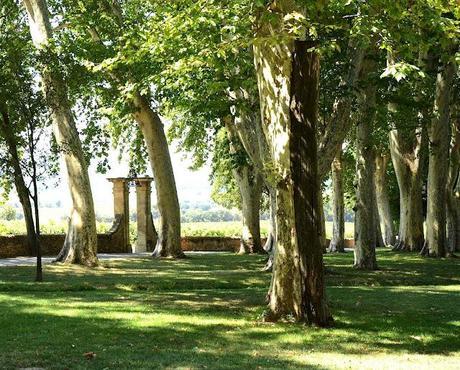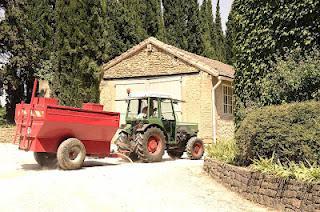map from www.vins-rhone.com
When I first visited Provence, I had no idea the Rhone appelation stretched down so far south. I had assumed that the Cotes de Provence region would hold my midday quaffers at local restaurants and I would be subject to miles upon miles of flabby whites and lolly-water rosés at the local Leclerc. To my glee, however, upon study of the map, I found some little towns and regions named similarly to words I recalled reading off bottles of spicy youthful reds in my own spicy youth while working at a forward-thinking Australian bottleshop of the 1990s (most Australians back then shunned any
vin un-Antipodean). Gigondas, Vaqueras, Ventoux and the big daddy, Chateauneuf du Pape.
Southern Rhone encompases quite a large area starting just south of Montelimar, and stretching over parts of Gard and through the Costieres de Nimes, across the Luberon, and almost down to Aix en Provence. While the northern Rhone wines, particularly appelations like Condrieu, Hermitage and Cote Rȏtie are synonymous with high quality, unaffordable and unapproachable-until-aged wines, the Southern Rhone has been known to produce approachable and berry-fueled reds, and voluptuous and fragrant whites that find their way into 4 euro carafes in tables with brown paper tablecloths, and 6 euro bottles at the local hypermarket. There are many great ones, and just as much mediocrity, but there are three subregions that I find always herald good taste - Chateauneuf du Pape, Lirac and Tavel.
The three regions can be visited in a day by car if you're a master on the spittoon - or a week on a wonky bike, stopping at tiny campgrounds and
auberges along the undulations. They rest on either side of Le Rhone just north of Avignon, a South-westerly diagonal line that works its way first through some very fine reds, then some incredibly flavoursome white, and finishing with some palate cleansing and serious dry rosé . I know, it sounds like I'm sending you in the wrong order, but after years of wine tasting in massive quantity, I can assure you, don't leave the big reds till last - your teeth will buckle under the pressure, and all you will taste are the phenols.
Chateauneuf du Pape is the most famous of my top three. The wines made are over 90% red, and rosé production is not permitted by
appelation control. The land is gently hilly, and heavily stoned. So prolific are these large creamy-red stones in fact, that you may be inclined to think they have been brought in by the vintners - but it is in fact natural. They have the perfect trait of holding the heat of the hot summer rhone sun, then retaining it through the night, protecting the ripening grapes from cold and frost, all the way through until the Autumn harvest. It's one of the warmest areas in France, but cooled by a dry wind that barrels through the valley like an army, giving the reds that lovely hot/cool climate tendency to be both rich and fruit-driven whilst retaining acid, and only very rarely showing baked fruit characters.

Chateauneuf reds are primarily Grenache, with added Syrah (Aussies call this Shiraz), Mouvedre (Malbec) and Cincault as common additives to achieve balance. They range from spicy and raspberry-laden through chocolate and coffee, and towards blackberry and tar depending on the vintage, the winemaking and the blend. Our visit with the lovely and helpful Caroline Clapier at Chateau La Nerthe showed us all three styles in three vintages - 2008, 2009 and 2006 respectively. The whites were equally impressive, and must never be overlooked when visiting the region. They are both fiercely aromatic and medium bodied - a pleasure to get away from the thinness that usually accompanies fragrance. They are usually a blend of Grenache Blanc, Clairette, Roussanne and Bourbelanc - each has its part to play - the Grenache blanc the soft base, Clairette similar - neutral, and when picked early can deliver welcome acid and lively lemon flavours. Bourbelanc, the late-ripener can pick up extra fragrance and spice and provide a strong backbone. Roussanne, holds the most individual character, and provides the aromatics that I love so much.


Expect to pay anything from about 20 Euros upwards for a decent example of white and 25 for red at cellar door. You will get something fairly knee-wobbling at around 50 to 60 euros. In addition to the spectacular
Chateau la Nerthe, with its baby roman arch and fairytale grove of Plane trees, visit
Clos St Jean for a touch of finesse,
Cave du Verger in town, for its cool cave and collection of many wines from the region,
Domaine de Pegau for its history and organic approach.
Next, we move to Lirac. The geography is fairly similar to Chateauneuf du Pape, if slightly flatter, and lower down. The reds and the whites are both excellent, and ready to drink fairly quickly after release. Better still, it's rare that you'll pay over 14 euros for a bottle. It's a small area and wineries are more difficult to find. But don't be put off - it's the kind of place you're likely to stumble upon one of the Rhone's best kept secrets, drink up some apricot-hinted Lirac gold, some rosé that tastes like roses, and then, when you want to go back for more, you find that you can no longer find it. Anywhere.

I like to call the white 'poor man's Condrieu' - it's usually a similar blend to the Chateauneuf whites, but often with added Viognier, giving it that furry richness that only that grape variety can posess. The reds are warm and soft, less complex than their neighbour's gutsy ones, but possibly more drinkable. Again, the grape varieties are similar, but with less oak and higher yields, a little gentler. Not perfect, but still more than worthwhile.
Lirac is one of the best bets on a Provincial winelist. They are inexpensive (never pay more than about 40 euros per bottle - they are usually about 20-25), crowd pleasing, and sometimes spectacular - the whites in particular. Many of the wineries in neighbouring regions will also have Liracs avaialble for tasting, so look out for them in Chateauneuf and Tavel. Within the region, seek out the stunning Chateau de Clary, and the tiny
Tour des Chenes.
Almost overlapping Lirac, you will find Tavel. As you traverse its gently swaying plains, you will continue to see signe "
Roi des rosés, Rosé des rois" - the king of rosé and the rosé of kings, and it is. It is the only appelation in France to produce only rosés, but never fear if you don't like the color pink - most of the vignerons also have land elsewhere, and the degustation will also usually involve at least Lirac and Cotes du Rhone wines.
The rosés from Tavel are usually deeper in color than other rosés of France, and also completely different in taste and texture. The flavours are more complex than either Loire or Provence rosés, ranging from raspberry and pomegranite through to almonds, minerals and spice. They are also much drier, and braced with steely acidity that gives the term "lolly-water" a little rock around, whilst not entirely pushing it off its pedestal. Tavel winemakers will tell you that it's also possible to age the wine for up to ten years. This, I'm not prepared to test - I adore it when it's glowing like redcurrant jelly and jumping out of the glass with vivacity.
The king of the kings, so to speak is
Mordoree, which can be found in the center of the township. They aslo make a sterling Lirac rouge. Look for
Aqueria, just out of town on the Route Roquemaure - and ensure that you also buy some of their Lirac blanc. Then go to Montezargues, where you can also get an eyeful of ancient architecture and a little olive oil.
-------------------------------------
All the above recommendations are linked. Many cellar doors are open every day in summer (with the obligatory closing over lunch), and can be spontaneously visited. It is worthwhile visiting the office de tourism in each town, as they can provide you with a map of wineries, otherwise just look out for signposts - the bigger labels are usually indicated. You will often find co-operatives in town also, where many labels can be tried in one sitting.
Please use the spittoon, even if you are not driving. This leaves you able to have a glass of wine with your meal when all the wineries are closed, and also ensures that you don't appear a drunken lout. There is quite a lot of wine to be tasted - and you will usually get poured 30ml per wine - that's a whole glass of wine at each cellar door if there are 5 on tasting. Trust me, a little dribble down the chin is nothing compared to wobbling into a wine rack and causing a meltdown.









